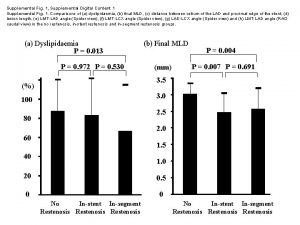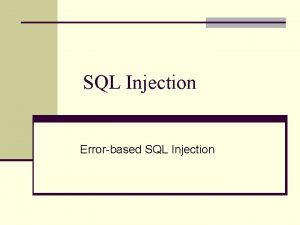Supplemental Power Point Slides Injection Drug Use in




- Slides: 4

Supplemental Power. Point Slides Injection Drug Use in Patients with Spinal Epidural Abscess: Nationwide Data, 2000 -2013 Alexander J. Toppo, BS 1; Ashley Rogerson, MD 2; David H. W. Oh, BS 1; David J. Tybor, Ph. D, MS, MPH 1; Alysse G. Wurcel, MD, MS 3; Matthew J. Salzler, MD 2 1 Tufts University School of Medicine, Boston, MA 02111, USA; 2 Department of Orthopaedics, Tufts Medical Center, Boston, MA 02111, USA; 3 Department of Geographic Medicine and Infectious Diseases, Tufts Medical Center, Boston, MA 02111, USA; Department of Public Health and Community Medicine, Tufts University School of Medicine, Boston, MA 02111, USA; Copyright © 2020 Lippincott Williams & Wilkins. Unauthorized commercial reproduction of this slide is prohibited

Injection drug use (IDU) is a risk factor for spinal Backgroun epidural abscess (SEA) d The prevalence of IDU among SEA patients and its effect on clinical outcomes is not well understood Objectives Methods To determine the proportion of SEA cases related to IDU To compare outcomes between SEA cases with and without IDU Retrospective review of the Healthcare Cost and Utilization Project National Inpatient Sample, 20002013 Patients with ICD-9 -CM diagnosis codes for illicit drug use or hepatitis C were classified as patients who inject drugs Clinical and hospitalization outcomes were compared between groups

Clinical Findings Results v. One in five SEA patients aged 15 -64 injects drugs v. IDU-SEA patients have longer lengths of stay, greater odds of leaving against medical advice, and greater hospital charges v. IDU-SEA patients were less likely to be diagnosed with cauda equina syndrome and less likely to receive surgical intervention v. From 2000 -2013, IDU-SEA became more common among younger (15 -34 -year-old), older (55 -64 -year-old), and white patients Discussion v. Higher rates of leaving AMA and difficulty with neurologic examination may have contributed to lower rates of surgery among IDU-SEA patients v. Chronic pain, withdrawal symptoms, and bias against people who inject drugs may have led to underdiagnosis of cauda equina syndrome v. Opioid use is increasing among the white and elderly

Year Figure 1. Annual percentage of injection drug use-related spinal epidural abscess (IDU-SEA) hospitalizations by race, National Inpatient Sample, 2000 -2013. 40% 2012 2010 0% 2008 2012 2010 2008 2006 2004 2002 0% 60% 2006 20% 80% 2004 40% 15 -34 Years Old 2002 60% 100% 2000 80% IDU-SEA by Age, % Whit e. . . 2000 IDU-SEA Cases by Race, % 100% Year Figure 2. Annual percentage of injection drug use-related spinal epidural abscess (IDU-SEA) hospitalizations by age, National Inpatient Sample, 2000 -2013.







